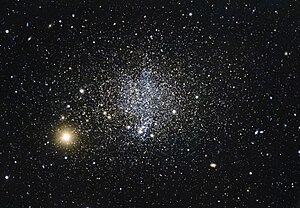Phoenix-Zwerggalaxie
aus Wikipedia, der freien Enzyklopädie
| Galaxie Phoenix-Zwerggalaxie | |
|---|---|

| |
| Die Phoenix-Zwerggalaxie aufgenommen mithilfe des Instruments FORS2 am Very Large Telescope | |
| AladinLite | |
| Sternbild | Phönix |
| Position Äquinoktium: J2000.0, Epoche: J2000.0 | |
| Rektaszension | 01h 51m 06,3s[1] |
| Deklination | −44° 26′ 41″[1] |
| Erscheinungsbild | |
| Morphologischer Typ | dIAm[1] |
| Helligkeit (visuell) | 13,1 mag |
| Winkelausdehnung | 4,9′ × 4,1′[1] |
| Physikalische Daten | |
| Zugehörigkeit | Lokale Gruppe |
| Radialgeschwindigkeit | (60 ± 30) km/s[1] |
| Hubbledistanz H0 = 73 km/(s • Mpc) |
|
| Entfernung | (1.440.000 ± 70.000) Lj / (440.000 ± 20.000) pc [2][3] |
| Geschichte | |
| Entdeckung | Hans-Emil Schuster, Richard Martin West[1] |
| Entdeckungsdatum | 1976[1] |
| Katalogbezeichnungen | |
| PGC 6830 • ESO 245-G7 • SGC 014903-4441.5 • AM 0149-444 | |
Die Phoenix-Zwerggalaxie ist eine irreguläre Zwerggalaxie im Sternbild des Phönix, die 1976 von Hans-Emil Schuster und Richard Martin West entdeckt und zunächst fälschlicherweise für einen Kugelsternhaufen gehalten wurde.[4][5] Sie befindet sich in einer Entfernung von etwa 0,44 Mpc von der Erde und gehört zur Lokalen Gruppe.
Eigenschaften
[Bearbeiten | Quelltext bearbeiten]Die Phoenix-Zwerggalaxie besitzt in ihrer Zentralregion eine Sternpopulation junger Sterne, die sich in einer Ost-West- und eine Population vor allem älterer Sterne in den Außenregionen der Galaxie, die sich in einer Nord-Süd-Richtung bewegen. Die Sternentstehungsrate in der Zentralregion scheint dabei relativ stabil konstant im Laufe der Entwicklungsgeschichte der Zwerggalaxie zu verlaufen (Martínez-Delgado et al. 1999). Im Jahr 1999 entdeckten St-Germain et al. ein H-I-Gebiet von etwa 105 M☉ direkt westlich der Phoenix-Zwerggalaxie. Dessen Radialgeschwindigkeit liegt bei etwa −23 km/s und zeigt wahrscheinlich eine gravitative Kopplung mit der Zwerggalaxie.[6]
Weiteres
[Bearbeiten | Quelltext bearbeiten]Weblinks
[Bearbeiten | Quelltext bearbeiten]- ESO: Ein explosiver Phönix 17. September 2018
Einzelnachweise
[Bearbeiten | Quelltext bearbeiten]- ↑ a b c d e f g NASA/IPAC Extragalactic Database
- ↑ I. D. Karachentsev, V. E. Karachentseva, W. K. Hutchmeier, D. I. Makarov: A Catalog of Neighboring Galaxies. In: Astronomical Journal. Band 127, Nr. 4, 2004, S. 2031–2068, doi:10.1086/382905, bibcode:2004AJ....127.2031K.
- ↑ Karachentsev, I. D.; Kashibadze, O. G.: Masses of the local group and of the M81 group estimated from distortions in the local velocity field. In: Astrophysics. Band 49, Nr. 1, 2006, S. 3–18, doi:10.1007/s10511-006-0002-6, bibcode:2006Ap.....49....3K.
- ↑ H.-E. Schuster, R. M. West: A very distant globular cluster? In: Astronomy and Astrophysics. Band 49, Mai 1976, S. 129–131, bibcode:1976A&A....49..129S.
- ↑ R. Canterna, P. J. Flower: A new dwarf irregular galaxy in the constellation Phoenix. In: Astrophysical Journal. Band 212, Letters, März 1977, S. L57–L58, doi:10.1086/182374, bibcode:1977ApJ...212L..57C.
- ↑ Sidney van den Bergh: Updated Information on the Local Group. In: The Publications of the Astronomical Society of the Pacific. Band 112, Nr. 770, April 2000, S. 529–536, doi:10.1086/316548, arxiv:astro-ph/0001040, bibcode:2000PASP..112..529V.
Text is available under the CC BY-SA 4.0 license; additional terms may apply.
Images, videos and audio are available under their respective licenses.

